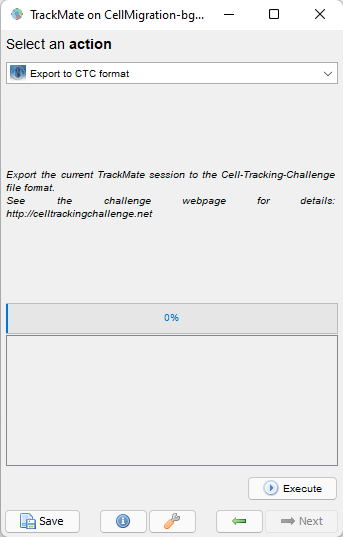Export tracking results in the cell tracking challenge format
The cell tracking challenge (CTC) aims to compare and evaluate cells and nuclei tracking methods objectively. To perform the evaluation, both segmentation and tracks predicted by a tracking algorithm are compared to manually annotated ground truth. Authors of the CTC developed several evaluation metrics to score the tracking quality and a tool to compute them. More information about the CTC is available on their website and publication:
TrackMate now allows users to export their tracking session into the CTC format to compute evaluation metrics (see tutorial below). The TrackMate helper also uses the CTC metrics to identify the best possible tracking parameters to use; more information about the TrackMate helper is available here.
Limitations
NOTE! There are some incompatibilities between CTC and TrackMate file format. Usually, they appear for problematic tracking results. They are due to the fact that TrackMate and the CTC format represents tracking results in a different manner: In TrackMate, objects are represented by an overlay of polygons and in the CTC format, objects are represented by label images, pixel by pixel. This led to some incompatibilities between the two in some marginal cases:
-
The CTC file format cannot process overlapping labels, but TrackMate can represent two objects that overlap fully.If an object fully overlaps with another one, it won’t be represented by at least one pixel in the label image and the CTC metrics will generate an error. The TrackMate CTC exporter tries to bridge those cases by removing the spot that is hidden in the label image and making a link with a gap over the removed spot. But this does not always succeed, for instance when the hidden object is the last or first in a track. In that case you will see in the Helper log the message: label not found.
-
CTC format does not allow a gap after cell division, which TrackMate accepts. When such a gap happens, CTC metrics cannot be measured.
-
In the CTC file format, tracks can be made of only one spot, which is not possible with TrackMate.
-
TrackMate can have merging events, which are forbidden in the CTC file format.
This will result in the exported files to be marked as inconsistent by the CTC tools, and the CTC metrics won’t be computed.
Export tracks in CTC format
- After a successful tracking session (automated tracking / manual tracking)
- In the action panel, select Export to CTC format and click Execute.

-
A new window will open where you can select where to save your files and the data type.
-
Select Gold truth if your tracking results were generated manually (human-made reference annotations, also called ground truths).
-
Select Silver truth if a computer algorithm generated the tracking results and you manually corrected them.
-
Select Results if a computer algorithm generated your tracking results.
-
-
Then, click OK.

-
Ground truths will be saved in a CTC format in your selected location. There will be two folders 01 and 01GT (if exported as Gold truth). The 01 folder contains the original data frame by frame. The GT01 folder contains two subfolders, SEG and TRA:
- The SEG folder contains reference segmentation for each corresponding original image. In the case of gold segmentation truth, manual segmentation needs to be is provided from selected frames (segmentation of each time frame is not necessary). In the case of silver segmentation truth, every frame is usually annotated, for example, by the Stardist segmentation integrated into Trackmate.
-
The TRA folder contains:
- A text file representing an acyclic graph for the whole video. Every row corresponds to a single track. Each track (row) is encoded by four numbers: Column 1 (L - label) - a unique label of the track (label of markers, 16-bit positive value). Column 2 (B - begins) - a zero-based temporal index of the frame in which the track starts. Column 3 (E - ends) is a zero-based temporal index of the frame where the track ends. Columns 4 (P - parent) - label of the parent track (0 is used when no parent is defined)
- Reference tracking annotations consist of cell markers interlinked between frames to form cell lineage trees. These are used to evaluate the detection and tracking performance of competing methods.
